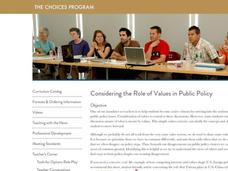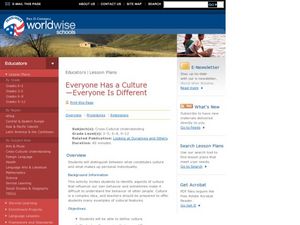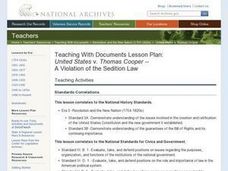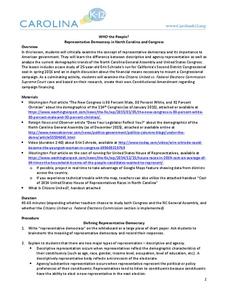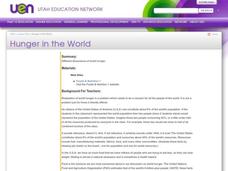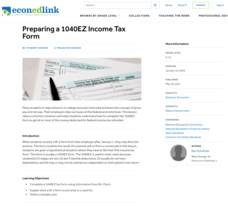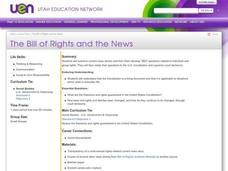Curated OER
Discovering American Symbols
Help youngsters get to know their states and capitals, explore their own country, and study American symbolism. They take a "trip" across America collecting symbols, images, and information about each state as they go (through text and...
Brown University
Considering the Role of Values in Public Policy
Strong opinions come from deeply held values. Young citizens explore the values that are most important to them in a class discussion and activity. As they prioritize a list of values cards that include freedom,...
Curated OER
Judges in the Classroom
Young scholars examine the classification categories of rights including liberty, security, cultural, and group rights. They identify and analyze the various similarities and differences among five countries and their constitutions.
Curated OER
Everyone has a Culture-Everyone is Different
Young scholars explore cultural features. In this multicultural acceptance lesson, students define and discuss "culture," and distinguish the difference between individual characteristics and cultural characteristics. Young...
Curated OER
United States v. Thomas Cooper --
High schoolers compare the Alien and Sedition Act to the First Amendment. They read and analyze a primary document and write a synopsis. They brainstorm challenges to the Government or President of the US.
Curated OER
The Jury System
Students analyze Article III and the Seventh Amendment. In this US Justice lesson, students research the US jury system and complete a Student Jury questionnaire. Students will discuss the impact the implementation of the Jury System had...
Curated OER
Limits of Power
Middle schoolers examine the importance of limiting power in governments. In this government lesson, students investigate the importance of placing limits on government by looking at the US Constitution. They look at ways that being an...
Curated OER
Fighting for Democracy, Fighting for Me
Ninth graders investigate specific individuals involved in Operation Iraqi Freedom and working backward to stories from World War II. In this US History lesson plan, 9th graders read documents that depict the conflicts faced by...
Curated OER
Press Freedom Versus Military Censorship
Eleventh graders explore the term terrorism. In this US History lesson, 11th graders participate in a press release on terrorism.
Curated OER
The Alien and Sedition Acts: Defining American Freedom
Eleventh graders explore the purpose of the Alien and Sedition Acts. In this US History lesson plan, 11th graders analyze primary source documents. Students write an essay using writing prompts.
Curated OER
Constitution
Fifth graders explore the importance of the Constitution. They read and discuss the meaning of each section. In groups, 5th graders create posters explaining an assigned part of the constitution. Using the internet, students research and...
Curated OER
A Constitution for Alaska
Pupils read sections cited from the Governing Alaska unit. They discuss factors that made Alaskans push for statehood. They view video A Constitution for Alaska.
Curated OER
Everyone Wants to Be President
How can you help your class understand the breadth of duties and the challenges of being the leader of the United States?
Illustrative Mathematics
Electoral College
A cross-curricular resource that takes the electoral votes and allows your learners to organize and analyze the data. Young voters can determine which states are more influential and interpret the dotplot provided for more data....
Carolina K-12
Who the People? Representative Democracy in North Carolina and Congress
Our elected officials are supposed to represent us, but what does it mean when they aren't like us? Budding citizens explore the demographic makeup of the US Congress, the role of money in political elections, and the Citizens United...
Curated OER
Water Down the Drain
Did you know that leaky faucets waste $10 million worth of water? Conservationists perform an experiment and draw best-fit lines to explore how the US Geological Society determined this value.
Minnesota Courts
Inside Straight: the Third Branch
Learners use the worksheet as they view the film Inside Straight: the Third Branch. Multiple case studies and the history of the judicial branch of the US government are included via hyperlink and act as the topics of discussion...
Museum of Tolerance
Disenfranchised People of the New Nation
Why are some immigrant groups in the United States embraced while others become disenfranchised? To answer this question, teams investigate why groups emigrated to the US, why some of these these peoples were...
Curated OER
Hunger in the World
Consider various aspects of world hunger in this writing lesson. After taking a pre-test, middle and high schoolers play a map game, analyze and discuss world statistics, and write a report on an assigned country. The lesson can apply to...
Judicial Learning Center
State Courts vs. Federal Courts
Popular culture often portrays the Feds as the most fearsome of law enforcement agencies. Yet, someone charged with a crime is considerably more likely to end up in a state court. The lesson, one of six covering the Organization of the...
Annenberg Foundation
Controversial Issues in Practice
Wow! This resource provides three related lessons on the First Amendment that challenge US government students to explore their personal opinion on the separation of church and state. Each lesson can be adjusted in length, but is...
Council for Economic Education
Preparing a 1040EZ Income Tax Form
Some of us never feel like we know how to do our taxes! Help scholars understand the process early by using an informative resource. They fill out their own tax forms in a simulation activity and view multiple resources to learn even...
Classroom Law Project
How do we hire a President?
What are the job requirements for the office of president of the United States? What attributes should a candidate possess? Are the qualities needed to govern the same as those needed to win? What can an analysis of the...
Curated OER
The Bill of Rights and the News
Students examine current news stories and from them develop "BIG" questions related to individual and group rights. They then relate their questions to the U.S. Constitution and supreme court decisions.

